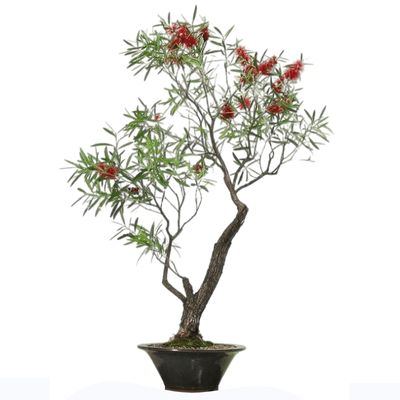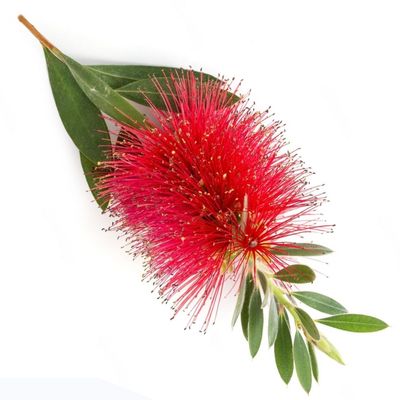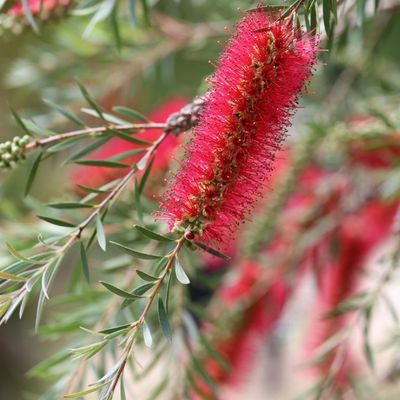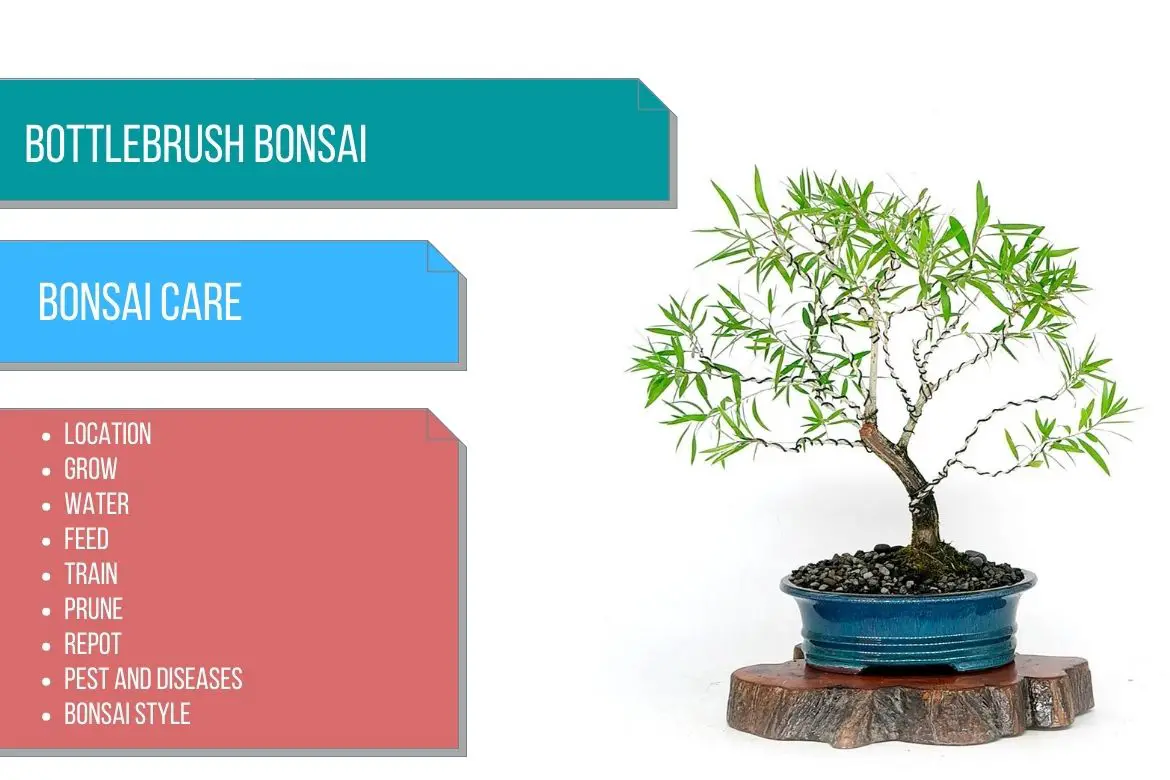
Narrow-Leafed Bottlebrush
(Callistemon linearis)
Country of Origin : Australia
Bonsai Styles : Formal upright, Informal upright, Slanting
Zone : 10 – 11
Bottlebrush bonsai tree is a wonderful candidate to consider for those bonsai enthusiasts who prefer a flowering bonsai tree.
One more added advantage of growing this bonsai is that you can display this beautiful bonsai indoors.
Interestingly, it is named so because its flashy flowers resemble the shape of a ‘bottle brush’. (Similar to powder puff tree : As its flowers resemble ‘powder puffs’. Powderpuff bonsai is also a great choice for an indoor flowering bonsai).
However, its flowers are not the only reason why this bonsai is preferred. Its brown, corky and fissured bark also lends the bonsai the appearance of an ancient tree. Hence, adding more character to the Callistemon bonsai.
The trees’ evergreen leaves are narrow and small and green to light green in color. The size of the leaves is suitable for making a small bonsai. However, the size of the dangling flowers is more suitable for medium to large bonsai size.

These delicate flowers contrast well with the small narrow green foliage of the tree.

A large group of showy flowers hang at the end of the branches.
There will be a display of long cylinders of bright red clustered flowers in late winter that will delight you. This beautiful display of flowers can last for more than a month.
Best location to keep Bottlebrush Bonsai
It is beneficial for a bottlebrush bonsai tree to spend the summer outdoors in full sun. However, this bonsai is also very well suited for indoor atmosphere.
The more light a bottlebrush bonsai receives, the tighter its growth will become.
During spring and summer, ideal temperatures range from 75°F to 90°F (23°C to 32°C), while during fall and winter, they range from 55°F to 65°F (12°C to 18°C).
When the temperatures drop below 45°F (7°C), it is advisable to keep the bonsai tree in a protected shed.
When kept indoors, place the bonsai container in a south or west facing window or windowsill. Minimum of 4-6 hours of sunlight is recommended no matter where you keep it indoors.
Refer sunlight requirements for indoor plants for more indoor gardening ideas. Also, refer to do bonsai trees need sunlight for more indoor and outdoor bonsai location ideas.
Propagation of Bottlebrush tree
Bottlebrush tree can be propagated using seeds and stem cuttings.
Take semi-mature wood stem cuttings (about 6 inches) in the time of summer. Apply some rooting hormone to the stems and plant them.
As far as seeds are concerned, the bottlebrush flowers have tiny fruits along their stems. Pick the fruits which are unopened and let them dry on a piece of paper. Let the fruits open and disperse the seeds.
It is important to note that the bottlebrush tree cross pollinates pretty easily. Hence the seed you are sowing might give you a hybrid variety of bottle brush tree. Hence opt for stem cutting instead.
Watering Bottlebrush Bonsai
Keep the Callistemon bonsai watering frequency such that the soil becomes a little dry to the touch between each watering session.
However, make sure that the bonsai soil is not bone dry.
Depending on your local environment, adjust your summer and winter watering frequency according to the thumb rule mentioned above.
Also, do not let the soil become too wet. Keep an eye on the drainage hole in the bonsai pot.
Spraying mist on the Callistemon bonsai tree is NOT advisable. As you run the risk of wetting the flowers. Wet bottlebrush flowers will wilt and eventually drop.
For the same reason, avoid watering the bottle brush bonsai from above.
Read watering bonsai tree for more details about immersion technique.
Wiring Bottlebrush Bonsai
Older branches of Callistemon bonsai become woody. Hence it is advisable to wire train young non/semi woody branches.
You can even try and wire older branches which are almost half an inch in thickness. However, keep the bends very gentle. Or they can break.
The bark of the tree is one of the main attractions of this bonsai. So be careful not to damage the bark.
Pruning Bottlebrush Bonsai
When to prune Bottlebrush bonsai?
How to prune Bottlebrush bonsai?
In the early stages of the tree’s development, prune it back hard to create a basic structure and ignore the flowers. At this stage focus on the structure of the tree, rather than growing flowers.
These trees are vigorous growers and hard pruning will encourage them to grow more.
To enhance the tree’s growth, allow the branches to grow (after hard pruning) and then cut them back during active growth. By doing this you will make the tree ‘fuller’.
Maintaining a good pruning routine is also important or else the tree will sag.
One of the best times to prune the tree is after flowering (you can also start pruning as soon as the flowers start wilting). Prune everything up til the seedpod. By this hard pruning, you will ensure that you get the best bloom in the next season.
This is also a good time to remove all the crossing branches or branches which are growing vertically up or down.
Note : It is never a good idea to remove all the new growth at once. The tree should be left with a little to sustain its health.
By the end of summer, you should stop pruning.
Repotting Bottlebrush Bonsai
When to repot Bottlebrush bonsai?
Late spring or early summer is a good time to repot the Callistemon bonsai tree.
Repotting can be done every 2-3 years.
While repotting, prune the roots of the tree as well. Do not remove more than 1/3 of the root system.
You can use a free-draining, bonsai soil mix. You can use slightly acidic soil.
Must Read: Bonsai Soil Recipes
Must read : Choosing the right bonsai container
Feeding Bottlebrush Bonsai
During active growth season, fertilize the Callistemon bonsaiper week with a well-balanced fertilizer at half strength.
Apply feed every two to three weeks if temperatures are above 55°F (12°C) during the fall and winter.
Read more about bonsai fertilizer and its application.
Diseases and pest of Bottlebrush Bonsai
Bottlebrush bonsai trees can be infested by spidermites and Sphaeropsis gall.
Sphaeropsis gall is caused by a fungus and if not treated in time, it will start killing all the branches. The branches will appear like a broom or will have knots. This is an over wintering fungus which makes it even more annoying.
Make sure that your bonsai is not water stressed, as water stressed trees are more susceptible to this fungal disease. Also, most of the fungal diseases are caused because of damp conditions. Make sure there is enough ventilation.
Remove the infected branches using a sterilized cutter. Also, apply a suitable fungicide.
Spidermites can also be problematic. Especially when the tree is grown indoors. Apply a systemic insecticide.
Bottlebrush bonsai care
Bottlebrush bonsai trees are prone to root rot if the bonsai soil mix is kept wet for a long time. Do not over water the soil.
As stated earlier, maintain a good pruning routine, or else you will quickly loose the look of the bonsai tree.
When keeping the bonsai outdoors, make sure that the bonsai is not exposed to water sprays or automatic sprinklers. The spray of water might wet the flowers and wilt them.

